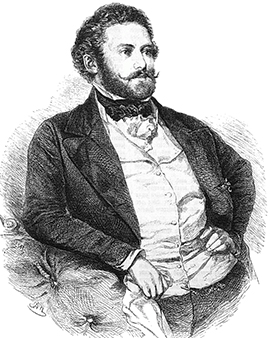


In the shadow of the Gothic towers of Danzig, in the Kingdom of Prussia, a modest boy named Eduard Hildebrandt was born on September 9, 1818. His father, a simple parlor painter, could offer him only the most meager comforts. But the lack of material resources could not stop the young Hildebrandt from discovering a passion that would change his world forever: painting. In the early years of his artistic journey, Hildebrandt overcame several obstacles. First, the art academy rejected him, believing he did not have enough talent. Despite this rejection, he joined the studio of Wilhelm Krause and began painting small marine pictures. This sideline allowed him to earn a living while saving for study trips. Over time, his talent continued to develop and he was eventually able to take his first study trip to the island of Rügen. Here he discovered his love for the landscape of the German Baltic coast.
A few years later, in 1841, on the recommendation of Krause, Hildebrandt was given the opportunity to go to Paris and become a student of the painter Eugene Isabey. This step in his career helped broaden his artistic horizons and solidify his reputation as a landscape painter. He even won a gold medal at an exhibition of the Paris Salon. Upon his return to Berlin, a recommendation from Baron Friedrich Alexander von Humboldt helped him take an extended trip to Brazil and North America. This trip was instrumental in shaping his artistic style and led to his specialization in landscape paintings with extraordinary light and shadow effects. His works were so impressive that they attracted the attention of the Prussian King Frederick William IV, who supported Hildebrandt financially and purchased his paintings. Shortly thereafter, Hildebrandt was appointed Royal Prussian Court Painter.
His later travels took him to Madeira, Africa, Italy, Egypt, Syria, Palestine, and even a world tour between 1861 and 1862. Hildebrandt captured the impressive variety and beauty of these places in hundreds of watercolors, drawings, and oil paintings, many of which were purchased by the Prussian king. His works also graced the collections of Tsar Nicholas I of Russia, his son Alexander II, the Duke of Ratibor, Clovis zu Hohenlohe-Schillingsfürst, and the Princess zu Sayn-Wittgenstein. Today, Eduard Hildebrandt's works are available both in originals and as art prints. As a company specializing in the production of high quality art prints, we are proud to reproduce the works of this extraordinary artist. Through our precise work, we are able to capture the charm and uniqueness of his works and make them accessible to a wider audience. After all, each art print is more than just a reproduction - it is a tribute to the artist and his immense creativity.

In the shadow of the Gothic towers of Danzig, in the Kingdom of Prussia, a modest boy named Eduard Hildebrandt was born on September 9, 1818. His father, a simple parlor painter, could offer him only the most meager comforts. But the lack of material resources could not stop the young Hildebrandt from discovering a passion that would change his world forever: painting. In the early years of his artistic journey, Hildebrandt overcame several obstacles. First, the art academy rejected him, believing he did not have enough talent. Despite this rejection, he joined the studio of Wilhelm Krause and began painting small marine pictures. This sideline allowed him to earn a living while saving for study trips. Over time, his talent continued to develop and he was eventually able to take his first study trip to the island of Rügen. Here he discovered his love for the landscape of the German Baltic coast.
A few years later, in 1841, on the recommendation of Krause, Hildebrandt was given the opportunity to go to Paris and become a student of the painter Eugene Isabey. This step in his career helped broaden his artistic horizons and solidify his reputation as a landscape painter. He even won a gold medal at an exhibition of the Paris Salon. Upon his return to Berlin, a recommendation from Baron Friedrich Alexander von Humboldt helped him take an extended trip to Brazil and North America. This trip was instrumental in shaping his artistic style and led to his specialization in landscape paintings with extraordinary light and shadow effects. His works were so impressive that they attracted the attention of the Prussian King Frederick William IV, who supported Hildebrandt financially and purchased his paintings. Shortly thereafter, Hildebrandt was appointed Royal Prussian Court Painter.
His later travels took him to Madeira, Africa, Italy, Egypt, Syria, Palestine, and even a world tour between 1861 and 1862. Hildebrandt captured the impressive variety and beauty of these places in hundreds of watercolors, drawings, and oil paintings, many of which were purchased by the Prussian king. His works also graced the collections of Tsar Nicholas I of Russia, his son Alexander II, the Duke of Ratibor, Clovis zu Hohenlohe-Schillingsfürst, and the Princess zu Sayn-Wittgenstein. Today, Eduard Hildebrandt's works are available both in originals and as art prints. As a company specializing in the production of high quality art prints, we are proud to reproduce the works of this extraordinary artist. Through our precise work, we are able to capture the charm and uniqueness of his works and make them accessible to a wider audience. After all, each art print is more than just a reproduction - it is a tribute to the artist and his immense creativity.
Page 1 / 1






